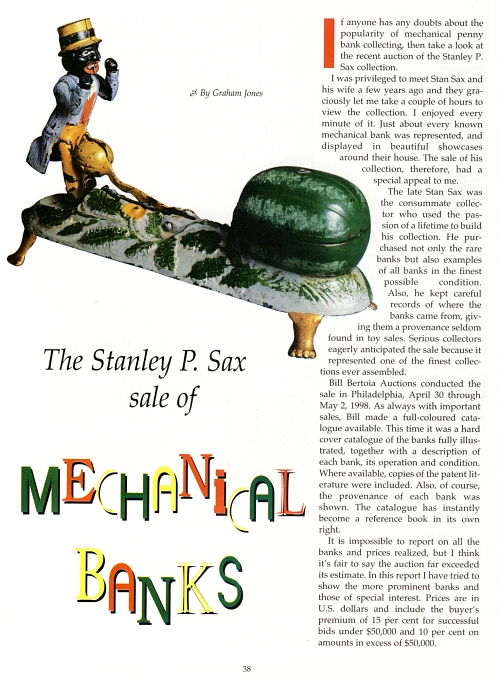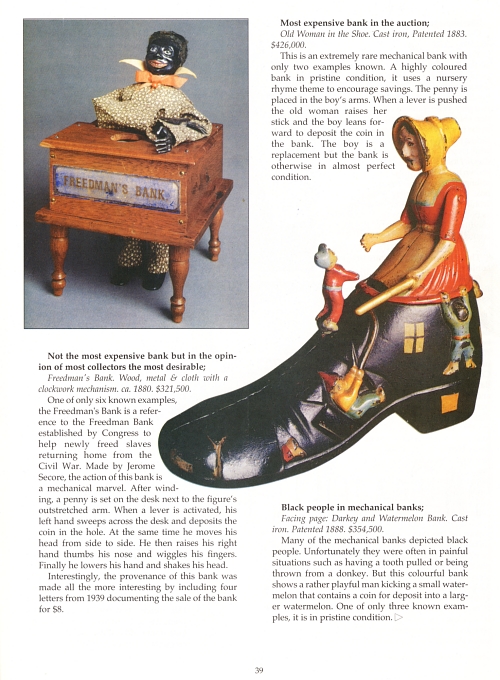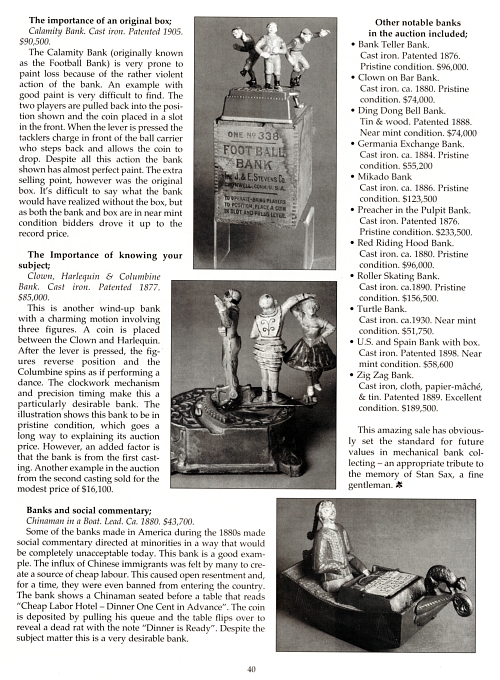|
Antique
Showcase
Canada's National Antique Magazine, October
1998
(Web Note: Reduced size page
scans with OCR text for easier reading below).



Antique
Showcase
Canada's National Antique Magazine, October
1998
the Stanley P. Sax sale of
MECHANICAL BANKS
If anyone has any
doubts about the popularity of mechanical penny bank collecting, then
take a look at the recent auction of the Stanley P. Sax collection.
I was privileged to
meet Stan Sax and his wife a few years ago and they graciously let me
take a couple of hours to view the collection. I enjoyed every minute of
it. Just about every known mechanical bank was represented, and
displayed in beautiful showcases around their house. The sale of his
collection, therefore, had a special appeal to me.
The late Stan Sax was
the consummate collector who used the passion of a lifetime to build his
collection. He purchased not only the rare banks but also examples of
all banks in the finest possible condition. Also, he kept careful
records of where the banks came from, giving them a provenance seldom
found in toy sales. Serious collectors eagerly anticipated the sale
because it represented one of the finest collections ever assembled.
Bill Bertoia
Auctions conducted the sale in Philadelphia, April 30 through May 2,
1998. As always with important sales, Bill made a full-coloured
catalogue available. This time it was a hard cover catalogue of the
banks fully illustrated, together with a description of each bank, its
operation and condition. Where available, copies of the patent
literature were included. Also, of course, the provenance of each bank
was shown. The catalogue has instantly become a reference book in its
own right.
It is impossible to
report on all the banks and prices realized, but I think it's fair to
say the auction far exceeded its estimate. In this report I have tried
to show the more prominent banks and those of special interest. Prices
are in U.S. dollars and include the buyer's premium of 15 per cent for
successful bids under $50,000 and 10 per cent on amounts in excess of
$50,000.
Not the most expensive bank but in the opinion of most
collectors the most desirable;
Freedman's Bank. Wood, metal & cloth with a
clockwork mechanism. ca. 1880. $321,500.
One of only six
known examples, the Freedman's Bank is a reference to the Freedman Bank
established by Congress to help newly freed slaves returning home from
the Civil War. Made by Jerome Secore, the action of this bank is a
mechanical marvel. After winding, a penny is set on the desk next to the
figure's outstretched arm. When a lever is activated, his left hand
sweeps across the desk and deposits the coin in the hole. At the same
time he moves his head from side to side. He then raises his right hand,
thumbs his nose and wiggles his fingers. Finally he lowers his hand and
shakes his head.
Interestingly, the
provenance of this bank was made all the more interesting by including
four letters from 1939 documenting the sale of the bank for $8.
Most
expensive bank in the auction;
Old Woman in the Shoe. Cast iron, Patented 1883. $426,000.
This is an extremely
rare mechanical bank with only two examples known. A highly coloured
bank in pristine condition, it uses a nursery rhyme theme to encourage
savings. The penny is placed in the boy's arms. When a lever is pushed
the old woman raises her stick and the boy leans forward to deposit the
coin in the bank. The boy is a replacement but the bank is otherwise in
almost perfect condition.
Black people in mechanical banks;
Facing page: Darkey and Watermelon Bank. Cast iron. Patented
1888. $354,500.
Many of the
mechanical banks depicted black people. Unfortunately they were often in
painful situations such as having a tooth pulled or being thrown from a
donkey. But this colourful bank shows a rather playful man kicking a
small watermelon that contains a coin for deposit into a larger
watermelon. One of only three known examples, it is in pristine
condition.
The
importance of an original box;
Calamity Bank. Cast iron. Patented 1905. $90,500.
The Calamity Bank
(originally known as the Football Bank) is very prone to paint loss
because of the rather violent action of the bank. An example with good
paint is very difficult to find. The two players are pulled back into
the position shown and the coin placed in a slot in the front. When the
lever is pressed the tacklers charge in front of the ball carrier who
steps back and allows the coin to drop. Despite all this action the bank
shown has almost perfect paint. The extra selling point, however was the
original box. It's difficult to say what the bank would have realized
without the box, but as both the bank and box are in near mint condition
bidders drove it up to the record price.
The
Importance of knowing your subject;
Clown, Harlequin & Columbine Bank. Cast iron. Patented 1877.
$85,000.
This is another
wind-up bank with a charming motion involving three figures. A coin is
placed between the Clown and Harlequin. After the lever is pressed, the
figures reverse position and the Columbine spins as if performing a
dance. The clockwork mechanism and precision timing make this a
particularly desirable bank. The illustration shows this bank to be in
pristine condition, which goes a long way to explaining its auction
price. However, an added factor is that the bank is from the first
casting. Another example in the auction from the second casting sold for
the modest price of $16,100.
Banks and social commentary;
Chinaman in a Boat. Lead. Ca. 1880. $43,700.
Some of the banks
made in America during the 1880s made social commentary directed at
minorities in a way that would be completely unacceptable today. This
bank is a good example. The influx of Chinese immigrants was felt by
many to create a source of cheap labour. This caused open resentment
and, for a time, they were even banned from entering the country. The
bank shows a Chinaman seated before a table that reads "Cheap Labor
Hotel Dinner One Cent in Advance". The coin is deposited by pulling
his queue and the table flips over to reveal a dead rat with the note
"Dinner is Ready". Despite the subject matter this is a very desirable
bank.
Other notable banks in the auction included;
Bank Teller Bank. Cast iron. Patented 1876. Pristine
condition. $96,000.
Clown on Bar Bank. Cast iron. ca. 1880. Pristine condition.
$74,000.
Ding Dong Bell Bank. Tin & wood. Patented 1888. Near mint
condition. $74,000
Germania Exchange Bank. Cast iron. ca. 1884. Pristine
condition. $55,200
Mikado Bank. Cast iron. ca. 1886. Pristine condition. $123,500
Preacher in the Pulpit Bank. Cast iron. Patented 1876. Pristine
condition. $233,500.
Red Riding Hood Bank. Cast iron. ca. 1880. Pristine condition.
$96,000.
Roller Skating Bank. Cast iron. ca.1890. Pristine condition.
$156,500.
Turtle Bank. Cast iron. ca.1930. Near mint condition. $51,750.
U.S. and Spain Bank with box. Cast iron. Patented 1898. Near
mint condition. $58,600
Zig Zag Bank. Cast iron, cloth, papier-mβchι, & tin. Patented
1889. Excellent condition. $189,500.
This amazing sale
has obviously set the standard for future values in mechanical bank
collecting an appropriate tribute to the memory of Stan Sax, a fine
gentleman.
|